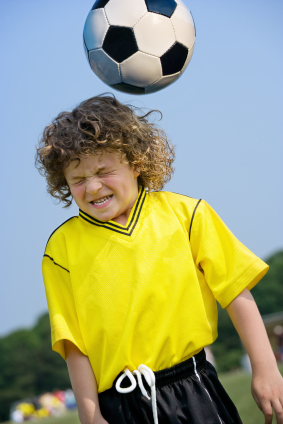While a 2010 study1 found no evidence that purposeful heading of a soccer ball leads
to either short-term (acute) or cumulative brain damage, such as
cognitive dysfunction, concussion experts nevertheless suggest that steps be taken to minimize the risk of concussive injury to youth soccer players, particularly younger players. 
Among the recommendations:
- Delayed teaching of heading. The American Academy of Pediatrics' Council on Sports Medicine and Fitnes Executive Committee recommended in 2010 that heading of a soccer ball only be taught when the child is old enough to learn proper technique and has developed coordinated use of his or her head, neck, and trunk to properly contract the neck muscles and contact the ball with the forehead. In doing so, it noted that the American Youth Soccer Organization (AYSO), with 650,000 participants, does not teach purposeful heading to players under age 10.
- Use of age-appropriate balls. "Although proper technique is foremost in reducing the risk of concussion from heading the ball," the AAP committee says, "it is also imperative that soccer balls be water-resistant, sized appropriately for age, and not hyperinflated.
- Strict rules enforcement. Citing statistics that foul play has been associated with a significant number of contact-related injuries, with girls' (11.9%) and boys' (11.4%) soccer just behind girls' basketball (14%) as the sports with the highest rates of such injuries, most of which were concussions or other head/facial injuries, the panel joined in the consensus recommendation of experts that proper rules enforcement and limitation of violent contact, with officials controlling the physicality of the game and emphasizing safe play with respect for one's opponents, could play a significant role in reducing contact injuries in soccer.
Smaller balls yes, delayed heading no
MomsTeam's concussion expert, William P. Meehan III, MD, Director of the Sports Concussion Clinic at Children's Hospital Boston, and author of the 2011 book, Kids, Sports, and Concussion,2 agrees with the recommendation on age-appropriate balls, but not the delayed heading advice.
"Some have suggested that perhaps children should not be allowed to head the ball until they reach a certain age and have become stronger and better coordinated. I believe, however, this would be a mistake. As children become stronger and better coordinated, they are able to kick the ball at a much greater velocity. It seems unwise," he writes, "to have their first time trying to head a ball occur at an age when the ball can be kicked with significant speed and force."
"Instead," Dr. Meehan suggests, "using smaller, softer balls that weigh less while children are younger allows them to develop the skills necessary for proper heading of the ball. This seems like a safer approach. They can learn proper technique, develop strength, and master the timing and coordination necessary for proper heading of the ball when young, before they begin to play with an adult-size ball that can be kicked with significant force." Learning to head with a dry, soft, foam ball, also might be a useful way to start, he says.
1. Pediatrics, February 2010; 410-414
2. Meehan WP, Kids, Sports, and Concussion (Praeger 2011).
Posted July 22, 2011








